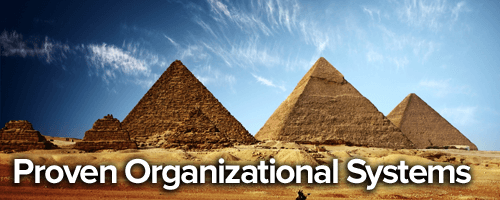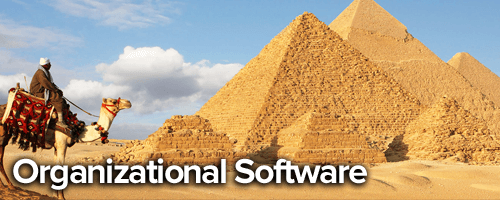- Joined
- Sep 3, 2014
- Messages
- 6,317
- Likes
- 13,295
- Degree
- 9

You might be able to get away with being lazy in regards to organization if you're building a micro-site or two. You won't be able to pull it off if you have 100 micro-sites (which stopped being a good idea in the late 2000's), and you definitely won't pull it off with a monumental authority site.
Why Organization is Critical
Organization is directly tied to your productivity. There are two options, and two options only:
- Contribute to Productivity
- Detract from Productivity
When you need to find a certain picture that you use frequently, are you going to go hunting across your computer's desktop among the 100's of random files and folders that aren't even in a grid, or are you going to dive straight into your file system and click on Business > Images > Frequents > image.png? Maybe you never find the picture on your desktop, so you lose time to recreating it.
When it comes time to file your taxes, are you going to attempt to export all of your Paypal transactions, Stripe transactions, Credit Card transactions, combine them chronologically, calculate expenses and revenues and then categorize them? Maybe you'll just shoot it all off to your accountant (and pay extra premium money for him to become a secretary for a few days to organize your stuff). Or you know, you could print receipts and file them as you go and enter it into your book keeping software daily, so when it comes down to crunch time there is no crunch.
Being properly organized is key to:
- Saving Time
- Saving Money
- Being Productive
Proven Organization Systems

Before we dive into actual productivity methods, we need to talk about having your tasks and information laid out in a sensible manner so you can attack it without having to bog down in thinking about what and when.
Chunking
Before you lay out your tasks, you need to break them into reasonable sized pieces that don't produce psychological resistance.
If you remember the discussion from Day 2 on Choosing a Niche & Direction, you'll recall S.M.A.R.T. goals. Let's break that down real quick.
Specific - What's the goal? Why am I doing this? Who else is required? Where is this happening?
Measurable - How long? How much? When is it done? How many?
Achievable - How is this completed and is it reasonable?
Relevant - Is this worth my time? Should I do it now? Am I the guy to do it?
Time-Bound - Is this urgent? How long should it take? What impact should it provide in the future?
Measurable - How long? How much? When is it done? How many?
Achievable - How is this completed and is it reasonable?
Relevant - Is this worth my time? Should I do it now? Am I the guy to do it?
Time-Bound - Is this urgent? How long should it take? What impact should it provide in the future?
Your goals don't have to be paragraphs each, but the answers to these questions should be in your head or easily answerable if you set the goal up correctly. Here's an example...
Instead of saying:
"Today I'm going to write blog posts till I'm sick of it then I'll go post my link to a ton of forums until bed time."
Try something like:
"Starting at 8 o'clock, I'll write one blog post every thirty minutes until noon. I'll take a 30 minute lunch break. Then, I'll create 10 engaging forum posts on five different forums, allowing 30 minutes per forum. Then I'll return and start my own thread with a link to my site. This thread will feature..."
Now you know how the next 7 hours of your day will be structured. Now you can chunk that out into 30 minute tasks, attach forum URLs, attach blog post topics, etc. Your goal is to remove the ability to procrastinate or slow down once you get into the flow. You don't need to be asking "when, what, where, why, how" at all once you start moving.
Master Files
Not much needs to be said here. Take all of your technical information and place it together in one file or one piece of software. Be careful with this. Don't put it on your USB drive that you carry with you everywhere. Don't put it in a hackable cloud service. Password protect it and keep it on your local drive.
Things to consider keeping in a master file (I prefer Excel with various sheets):
- Your hosting logins and passwords
- Your billing schedules, URLs, logins, passwords
- Your domains, where they are hosted, the registrar, the expiration dates
- Your affiliate network URLs, logins, passwords, payment schedules
- Your social network URLs, logins, passwords.
To-Do Lists & Calendars
Now that you've got everything chunked out, it's time to organize it. That basically means putting it in the order of important or time-constraint and attaching all relevant and needed information to complete the task.
If only life were that simple. You're going to have engagements, commitments, ideas that aren't actionable yet, long-range goals, etc. You can't just generate your to-do list for the day out of thin air. You need to have everything laid out and becoming increasingly organized as it's time to shine comes closer and closer to the present.
I know I don't have to explain to-do lists and calendar views. People dig them. I don't, but it's definitely something to explore using. I'd use a software that can sync to Dropbox or some other cloud service so I can access it from my phone, my desktop, my laptop, no matter where I'm at.
When ordering your to-do list, make a numbering system for prioritizing. Here's a suggestion:
- Largest impact item that can be done now.
- Time constrained item that must be done at this time.
- Items for preparing and supporting top priority items.
- Not urgent but should happen eventually and are worth it.
- Smallest impact items with no time constraints.
Kanban
This has become the staple of my organization. It's a Japanese system designed to accomplish chunking, never dropping the ball or letting something fall through the cracks, and identifying bottlenecks.
Bottlenecks: When you spot a bottleneck (meaning that until this item is completed, everything starts to slow down and bog down behind it), immediately identify why this is happening and develop more efficient methods of completing the task. If you're constantly fixing bottlenecks, your entire business will begin to hit lightning speed. Eventually your slowest item is completed at 99% the speed of light.
The Kanban system is comprised of a set of boards. You should have a board for each of the following time blocks:
- To-Do
- Doing
- Completed
- Ideas
On the boards, the cards are organized vertically with the highest priority items on top. When you begin to work on the most important item, it slides over to the Doing board. You get the picture. This works for individuals or entire teams, where labels for team mates can be applied, color coding can be done for the type of activity it is, etc. In this way, all that has to happen is looking at your overall Kanban picture and everyone is up to date immediately. If a card is already in "Doing" then you don't interfere unless asked.
Proven Productivity Methods

So you're using either the Kanban system, a To-Do list, or a Calendar, or some combination. That's pretty much the options. You are supremely organized and ready to get stuff done. What's the most efficient way of doing things?
There's lots of advice you'll find out there like...
- Meetings are a waste of time, put a time limit on them.
- Don't check your email first thing in the morning.
- Lock your door and turn off your cell phone.
However, there are some axioms you can integrate into your life that are generalizable and applicable to everyone. The reason this works is that we all have certain resources that are limited:
- Willpower
- Emotional Energy
- Time
- Money
Outsourcing & Automating
We've had a full day on this topic so I'm only going to mention it in TL;DR fashion. Sometimes you run out of time, so you use your money to employ someone else's time and willpower. Sometimes a task is below you and you don't have the emotional energy and willpower to get it done, knowing you're wasting your time when it's better spent elsewhere. So you employ a computer to do it. You get the point. You use your money to free your time, energy, and willpower.
Eat the Frog
When you first start your day, your gas tank is full. You have maximum willpower for the day and you've not expended any emotional energy yet. You're full of enthusiasm, nobody has pissed you off yet, etc. This is when you need to "eat the frog," which means identifying the task that is most complex or most annoying (but still worth your time), and just knocking that sucker out. Get it done. The rest of your day will run smoothly and you'll get far more completed in the later portions of your day. When there's nothing to procrastinate about later, you won't procrastinate.
Kill Small Tasks Immediately
Stuff pops up, it's inevitable. It's super annoying. But you know what's more annoying? Looking at your to-do list and getting overwhelmed by the number of tasks on it because you let them build up. Now you're nervous, you're anticipating a huge work load and you compound it by playing a round of Solitaire instead, then you start drinking, and next thing you know you're robbing banks. Your goal here is to use time to save time and energy. It's unintuitive but it works.
If a small task pops up and you estimate it will take less than 3-5 minutes to get it out of your life for good, do it. Send that email. Chase down that person. Make that phone call. Whatever it is, just do it and be done with it. Do not let small tasks come together to form a monstrosity. This is all about controlling your psychology. That's why we chunk. But too many chunks is scary and will grind your gears to a halt. Kill small tasks immediately.
Pomodoro
We all have maintenance style tasks that have to be touched on schedule. If we go balls to the wall all day every day on the top-most priority task, our empire will crumble. This is why, when I talked about our chunking example with S.M.A.R.T. goals, I referred to 30 minute time blocks. Go balls to the wall for 30 minutes and then re-evaluate.
Take those maintenance tasks and assign them to 30 minute slots and touch them. You can minimize your involvement with them to save time while ensuring your business doesn't rot and get condemned by your customers. This might include a daily blog post, 5 blog comments a day, approving blog comments, moderating forums, customer service, chasing down money, greasing connections, closing loops, etc. Ignoring these things are detrimental. Becoming consumed by them is detrimental. Touch and go is what you want.
You do this using the Pomodoro method, which classically says to work 25 minutes on and 5 off. That's your 30 minute block where you hyper-focus then take a micro-break. After every four blocks, take a longer 15-30 minute break.
Not only is this a good way to touch and go on everything, but it also keeps your willpower high. It keeps you from getting bored with a single task. When you rotate or even just bounce back and forth between two tasks, you'll keep your self moving fast instead of slowing down to a bored 60% effectiveness.
Time Off
When it's right, take time off. This can be a couple hours per night. This could be 8 hours a night. This could be only Sundays, or it might be a 3 week vacation once per year. It might be whenever you're ready to kill someone so you just go outside and take a walk.
You'll know what's right for you, but don't lie to yourself either. This is easily abusable.
This is trading time to save time, energy, and willpower. When you step away, you recharge all three of those batteries. You gain unrelated experiences, have adventures, become exposed to new things, and all of this goes into your mind. Your brain will chew on it and suddenly you find that you're some new creative powerhouse that's excited about work again. That's because you stopped being confined to the pack of 12 crayons and went out and got a few new colors.
Cleanliness
You'd think this goes without saying. Take your computer desktop and clear it of most everything. You want a giant blank canvas. Take your physical desk and clear it most everything. Anything left, give it a place to exist and keep it clean.
Your external environment is a reflection of your internal environment. If you're a mess on the inside, you'll tolerate a mess on the outside. But it's a feedback loop. So clean up your physical surroundings and keep them clean and organized and you'll find your mind coming into alignment as well. Productivity will shoot through the roof.
Organizational Software

I wouldn't tell you about all these to-do lists and calendars and Kanbans without pointing you in the right direction. Here are some pieces of software that sync up to all of your devices through the cloud and have proper apps for your mobile phone and tablets. The name of each is a hyperlink for your convenience. Each one is perfect for individuals but also for teams, and mixtures of both.
Trello
This is your go-to for the Kanban system. I've tried a thousand methods and a thousand pieces of software. This is what I lean on now.
Evernote
This is for creative people who collect inspiration. While you can create to-do lists, presentations, and whatever else, it functions more like a scrapbook for pictures, content, charts, and then taking notes about them. I don't use this but I know several people who get insane value from it.
Wunderlist
This was my go to before I knew about Kanban and was still using typical to-do lists. It has a nice UI, can give reminders on deadlines, do all the color coding and flagging of items, add attachments, and whatever else you might expect of a top of the line to-do list software. It was the best to-do list I found. If that's your thing, try this one out.
Asana
This is amazing. If I was an agency owner, I'd have my team using this. This accommodates complexity when you can't get away from it. Everything I do is solo or with small teams, so I stick with Trello, but if I ended up on a team of 10+ people, I'd highly consider pushing us all to Asana, especially for the discussion aspect of it.
Spreadsheets
There's no link here. We all know about Microsoft Excel, Mac Numbers, Open Office, etc. The point is spreadsheets are one of the most amazing organizational tools ever invented and I don't ever see them going away. Ever.
Conclusion

That's it. You could carry on about organization and productivity forever. Corporations pay ridiculous sums of money to train people, bring in speakers, paying for seminar tickets, all because this topic has an insane impact on your bottom line. Get it together! If you're sloppy or lazy, you're screwed. Don't sabotage yourself from the get go.
Remember I said that nobody wants to steal your master file? Well, that's if you don't run around making yourself a target. The day after tomorrow @SmokeTree will be telling you all about how to remain anonymous online and securing your servers and computers so you'll never have to sweat that issue. And that is part of organization too!
